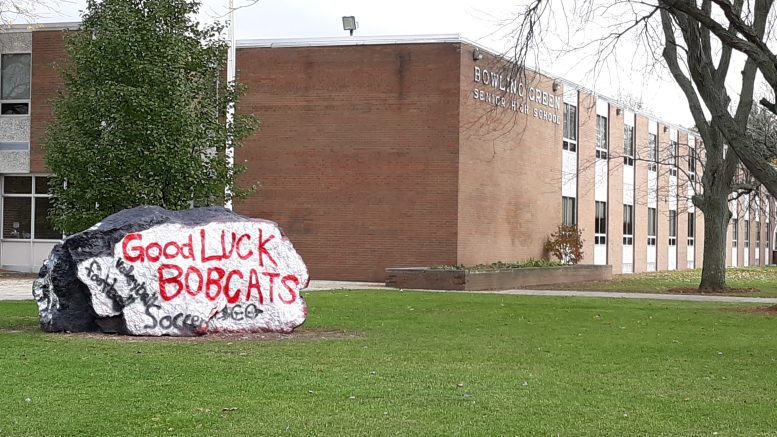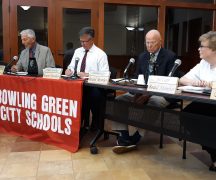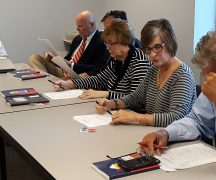By JAN LARSON McLAUGHLIN
BG Independent News
In a trade to get Bowling Green City School teachers vaccinated against COVID-19, the district has agreed with the state requirement to bring students back into the classrooms by March 1.
But there are many questions still to be answered. When will the vaccines be available for the 300-plus staff who want the shots? Will students go back in hybrid form or full-time? Will all grades go back at the same time? Will other options be offered to parents who don’t want their children to attend school in-person?
The Board of Education’s nearly four-hour meeting Tuesday evening was not long enough to answer all those questions. So a special meeting has been scheduled for Jan. 28 at 5:30 p.m. to continue the discussion.
The school board has focused on keeping teachers and students safe during the pandemic, and is the only district in the county to not hold any in-person classes this school year. The board has been waiting for the vaccine – but now that it’s here, it may not be in quantities enough to quickly cover the teachers and staff.
Teachers move to the front of the vaccine line
School employees throughout the state qualify for the vaccine starting on Feb. 1 – but only for districts vowing to offer in-person classes by March 1.
“We were forced to make a commitment,” Superintendent Francis Scruci said Tuesday evening.
So far, about 75% of Bowling Green teachers and staff have signed up for the vaccines.
But Wood County Health Commissioner Ben Robison said that school staffs will be sharing the delivered doses for adults 70 and older.
“Our hope is that in two weeks we get 5,000 doses for Wood County,” Robison said. “We’ll take as many doses as we can get.”
The health department normally finds out every Thursday how many doses will be delivered in the next week.
“We are highly dependent on the supply chain,” Robison said. “It is possible we will get a fifth of what we need, or a tenth of what we need.”
The first dose of the vaccine provides about 50% efficacy, and the second dose about 95%.
Stats show COVID not being spread in schools
Robison also presented updated information Tuesday about the spread of COVID in schools.
A semester of collecting data in local schools shows that there are very few cases of students and teachers getting COVID from classroom exposures, he said. Contact tracing has shown that students aren’t taking the virus home from school.
“That really hasn’t happened,” Robison said.
Districts that follow the rules for masks and social distancing are not contributing to community spread of the virus, he said.
The one exception has been in sports. “We have seen spread there,” Robison said.
The health department’s epidemiologist told Robison that the spread of COVID in classrooms “is so rare, I don’t have a number for you,” he said.
The last time Robison met with the Bowling Green board, he did not have that information.
“Now we have an entire semester worth of data,” he told the board Tuesday.
Board member Jill Carr asked about the new strains of COVID that are appearing.
“We’re encouraged that the vaccines we have seem to be working against it,” Robison said.
New standards should make it easier on schools
Robison also reported on new guidelines for social distancing in schools from the Ohio Department of Health. While social distancing in middle and high schools will remain at a recommended 6 feet, it has been reduced to 3 to 6 feet in elementaries. And if students who may have been exposed to COVID are symptom free, they can remain in their classrooms.
There will always be risks – but following the guidelines minimize them, Robison said.
“There is no way to eliminate all risk when our kids go to the classroom,” he said.
School districts with in-person classes have struggled with kids having to quarantine if they have been exposed to someone with COVID. That is an “unavoidable reality,” Robison said. However, he repeated that he does not expect a surge in actual COVID cases for schools moving from remote to in-person.
“I have every confidence Bowling Green City Schools has the skills to impose the guidelines effectively,” he said.
County’s numbers looking better
Though still at Level Red, Wood County’s COVID numbers are looking better, Robison reported. But he cautioned, “We still have a long way to go.”
The number of cases per 100,000 have dropped from 826 to 500, and the number of active cases is down to 288 today. CDC considers anything over 100 per 100,000 people as a “high incidence” rate.
“That’s certainly no cause for letting our guard down,” he said. “But the trend is in the right direction.”
Several decisions to be made
Robison offered the school district assistance regardless of what the board decides.
“You have some options in front of you as a board,” he said. “I recognize the tough position you are in and want to be a resource for you.”
Scruci applauded the board for putting safety first.
“This board prioritized health and safety from day one,” he said. “There were difficult decisions you’ve been forced to make.”
“We want our kids back in school, because that’s where kids learn best,” he said – but only if staff, students, families and the community are safe.
Parents in the district were surveyed about their preferences about in-school or remote learning in December. It was suggested that perhaps new surveys should be sent out with updated information and questions, but Scruci cautioned that the surveys require a lot of follow up work for staff since only about 60 to 65% of families respond.
Teachers’ viewpoints given
Jeff Nichols, president of the Bowling Green Education Association, gave the board an overview of where teachers stand on returning to in-person learning.
“Every teacher has a different opinion, and different reasons for their opinion,” Nichols said. However, teachers were happy in November when the board adopted a matrix of when it would be safe to return students to classrooms.
“Teachers were pleased that decision came,” he said. However, that matrix – in its current form – will likely have to be scrapped if the district returns to classes by March 1.
Though they have different opinions, the teaching staff agrees that the remote system used by Bowling Green has provided more consistent education than at other districts where students are quarantining and missing school, or classes bounce from in-person to remote.
“We 100% agree we have delivered a consistent educational experience for our students,” Nichols said.
The teachers also agree that it would be “absolutely and unequivocally safer,” if they got at least the first dose of the vaccine before in-person classes begin, he said.
“Our teachers want kids back in school,” but they also want to be safe and to provide consistent education, Nicholas said.
So what’s next?
“We have committed to do it by March 1,” board president Norm Geer said. So what are some of the options?
One board member suggested starting the elementary classes full-time and the secondary classes as hybrid. Another suggested starting with hybrid classes in the elementaries early in February, followed by the middle and high school classes no later than March 1.
“The sooner we can get the kids back, the better,” board member Tracy Hovest said.
Some board members want to wait to make sure teachers get at least one dose of the vaccine before students come back.
“Since day one, this has been about the kids – keeping the kids and teachers safe,” board member Ginny Stewart said. “I’d like this to be based on the vaccine.”
“I don’t think it’s fair to ask our teachers to go back until there’s at least one vaccination,” she said.
Board member Jill Carr agreed.
“I want to maximize that to every extent that we can,” she said.
But board member Ryan Myers returned to the data presented by Robison.
“The spread is not happening,” he said.
“I’m not sure why we’re waiting at this point,” Myers said.
Hovest asked Scruci to make a recommendation to the board.
“We don’t go back to school until our staff has had the first vaccination – minimum,” Scruci said.
More options to be offered?
For those parents who want their children to remain in remote learning, the only current option is the NOVA program. But at least three board members – Geer, Carr and Stewart – suggested that the district look into other online options.
“Choice is very important,” Stewart said.
But Hovest pointed out that other families have been asking for in-person learning options since the beginning of the school year.
“We haven’t given all our families a choice from the get-go,” she said. “Six months have been devastating for their families.”
Scruci pointed out that the district just received a petition with 102 signatures from families asking for more online options.
Again, Hovest responded.
“There were 1,000 on the last survey, and we didn’t take that into consideration,” she said of families wanting in-school options.





